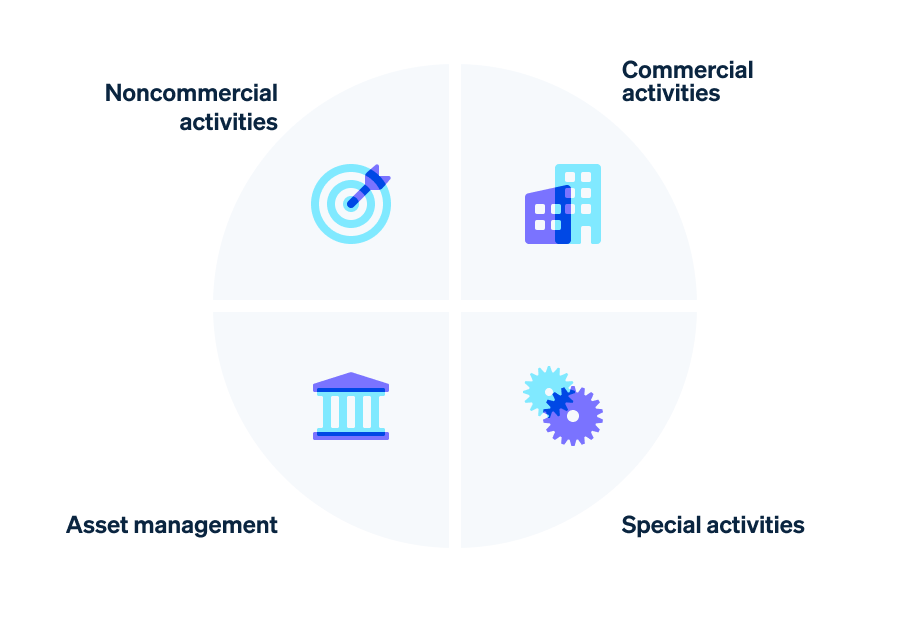2022 年,在德国注册的社团超过615 000 个,并且这一数字还在继续增长。社团之所以受欢迎,是因为它们将志趣相投的人们聚集在一起。此外,社团还能享受减税和政府资助等各种优惠。不过,值得注意的是,社团在会计实务中必须遵从多项法律规定。
在本文中,我们将探讨社团的会计处理要求,并概述适当会计原则。我们还将介绍社团的会计事务负责人、社团是否可以自行记账,以及错误会计处理可能造成的后果。此外,文中还将提供一些小技巧,帮助您简化社团的会计流程。
本文内容
- 社团的基本会计要求是什么?
- 适当会计的原则是什么?
- 社团的账目负责人是谁?
- 社团能否自行管理账目?
- 社团账目出错的后果?
- 如何让社团的会计工作变得更轻松?
社团的基本会计要求是什么?
从法律上讲,注册社团是指"无论法律架构如何,多数成员(个人或实体)为共同目标长期自愿结合并遵循有序决策程序的组织"(见《社团法》第 2 条第 1 款)。
无论是体育俱乐部、射击俱乐部还是非营利组织,社团都是公认的法律实体,必须遵守社团会计要求。这些要求基于法律上税务要求以及社团的章程规定。这是因为成员大会可以请求对社团的财务工作进行审计,税务局也可以社团收支进行审计。收入和支出分为以下四类:
- 非商业活动: 该类别包括与社团使命直接关联的非商业活动。这就包括会费,以及捐赠、赠予和遗产收入。此类别中的支出可包括行政费用、俱乐部设施租金或教练津贴。
- 商业活动: 该类别包括任何超出社团既定宗旨的创收活动。例如,此类别中的收入可能来自在活动中销售食品和饮料。
- 特殊活动: 特殊活动是社团内部支持其合法目的并对实现该目的至关重要的业务活动。社团章程将其与商业活动区分开来。例如,收入可能来自销售协会活动门票。支出包括租赁设备或为活动聘请专业人员等费用。
- 资产管理: 资产管理涉及出租或租赁协会拥有的财产等活动产生的收入。在社团车辆上出租广告空间等活动也可能产生收入。支出可能包括建筑维护或保险费用,以及银行账户费用。
社团的活动领域

社团自注册并开展商业活动起,无论是否谋求盈利,均必须立即开始记账。所有业务交易都必须完整记录在案,包括收支明细,以及现金和账户余额。账目还必须编制一份社团的资产清单,如社团拥有的不动产、车辆、设备、机械或实验室设施等。
社团的纳税申报表必须在截止日期前编制并提交。对于营业额和利润可控的小型社团,采用收付实现制会计(德语为 "Einnahmenüberschussrechnung "或 "EÜR")即可(参见《所得税法》第 4 条第 3 款)。如果社团的年营业额超过 600,000.00 欧元或年利润超过 60,000.00 欧元,则必须使用复式记账法进行会计核算。
妥善保存所有交易收据或文件,以便核验收入和支出,这一点至关重要。这是因为社团必须遵循与公司相同的适当会计原则。
适当会计的原则是什么?
适当会计原则的最新版本自 2020 年起生效。它被称为GoBD,是德语 "Grundsätze zur ordnungsmäßigen Führung und Aufbewahrung von Büchern, Aufzeichnungen und Unterlagen in elektronischer Form sowie zum Datenzugriff"的缩写。这项由德国联邦财政部颁布的法规,明确了税务相关文件数字化处理的基本原则,适用于所有企业和社团。
GoBD 的核心原则包括:
- 可追溯性和可验证性:协会的会计记录必须完整、清晰且简洁。
- 完整性:每笔业务交易都必须按照保存期限记录在案。收入和支出收据必须包括日期、金额、数量、收据编号以及出具方与接收方。
- 准确性: 所有业务交易必须如实记录,并反映实际交易情况。为此,相应收据要归档。
- 及时入账和记录: 及时记录也是适当会计的关键。所有业务交易都应在发生后及时记录。法律规定非现金交易应在 10 天内入账,而现金收支则必须每天入账。
- 有序性: 记录应便于第三方(如审计师或税务顾问)轻松了解社团的会计情况。系统化会计需区分现金与非现金交易,并将销售分为应税、免税或非应税项目。所有收据必须为机器可读格式。
- 不可篡改性: 会计文件的存储方式必须确保其无法被更改或篡改。后续所作的任何变更,均必须进行透明的记录。任何修改后的文件均必须重新保存。此外,还须依法保留版本历史记录。
只有遵从这些原则,社团的会计工作才符合GoBD。更多细节可参阅我们关于 GoBD 的专题文章。
社团的账目负责人是谁?
董事会负责维护社团的会计核算工作,并确保遵循适当会计原则。由于董事会负责管理社团的财产及业务,因此其负有谨慎管理与问责义务。这就包括向成员大会提供信息等责任。通常情况下,董事会每年通过提交社团上一年度的财务报表来履行该义务。这一要求在社团章程中有详细规定。
董事会通常会任命一名财务主管来监督财务工作,也可以任命一名审计师。不过,无论如何,董事会仍要对会计准确性承担最终责任。
社团能否自行管理账目?
社团可自行处理记账工作。这种方法尤其适用于成员较少、营业额可控的小型社团。在这种情况下,无需专业知识。不过,负责人应具备基本的簿记知识,类似于编制所得税申报表所需的知识。
在这种情况下,建议使用专业社团会计软件简化流程。重要的是,要遵循适当会计原则。使用软件的主要优势在于可以自动处理许多日常任务。
这些任务包括创建损益表;管理收入和支出;按特定类别记录交易并将其分配到不同账目;生成发票、捐赠收据或催款单;以及规划社团预算等。此外,软件还会自动更新,以满足新的监管要求。每年的费用通常从几十美元到几百美元不等,具体取决于所管理的人数或有权访问该程序的人数。
然而,对于收入高、成员多、雇有员工或持有不动产的社团,自行管理会计工作可能面临巨大挑战。在这种情况下,建议向第三方寻求帮助或外包会计工作。可以考虑委托专业服务机构或会计师来管理账目。
Stripe Billing可以帮助您为成员定期开票。它还可以实现工作流程自动化并减少手动任务。此外,您还可以通过仪表板直接管理账目并查看详细的财务和收入报告,使您的账目管理工作更加轻松。您还可以通过客户门户让客户独立管理订阅。
评估会计成本和预算是需要逐案考量的重要事项。也可以采用混合解决方案,即只外包特定交易,而不是整个会计流程。除收取会费外,社团还可以使用 Stripe 处理向非会员销售商品和服务的事宜,或接收捐款。
社团账目出错的后果?
社团必须遵从 GoBD 的规定并按时提交文件,否则可能面临高昂代价。
错过截止日期可能导致滞纳金和逾期款项的利息。社团应全面收集信息,确保所有文件完整并按时提交。如果无法按时提交,建议联系税务局进行沟通。税务局通常会在及时通知的情况下给予配合。
如果税务局在审计过程中发现会计工作存在漏洞,可能会发出补缴评估通知。为了确定适当的征税依据,缺失的收入或支出将按最高概率进行估算。如果社团被怀疑涉嫌逃税,问题将更加严重。在这种情况下,社团可能面临巨额罚款,董事会成员可能需以个人资产承担赔偿责任,甚至最高可判处10年监禁。
如何让社团的会计工作变得更轻松?
获得非营利组织身份可以简化社团的会计工作。这是因为非营利组织可免征贸易税、企业所得税和增值税。不过,只有当社团满足于小型企业规则规定的相同标准时才适用,即:上一年度年营业额不得超过 22,000.00 欧元,且当前财政年度的年营业额必须低于 50,000.00 欧元。
此外,非营利组织可以开具捐款收据,因此捐款可以用于抵税。非营利组织的另一个好处是可以申请政府资助。不过,这些资金必须用于特定目的,而且必须充分证明其用途。非营利组织身份提供了多种优惠和简化措施,但也要求保留更详细的记录。
近年来,数字化发展简化了社团的会计工作。Stripe Billing 等专业解决方案简化了会计流程,提高了效率与透明度。分账和数据录入等手动任务被最小化和自动化。发票可以自动生成,收到的发票可以更快地处理和归档。支付流程也可以实时追踪。对于社团和公司来说,使用技术工具或第三方服务都是值得的。这有助于避免错误,从而降低成本和减少额外工作。
本文中的内容仅供一般信息和教育目的,不应被解释为法律或税务建议。Stripe 不保证或担保文章中信息的准确性、完整性、充分性或时效性。您应该寻求在您的司法管辖区获得执业许可的合格律师或会计师的建议,以就您的特定情况提供建议。